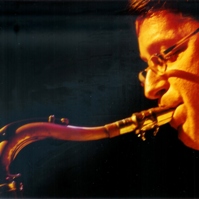
Steve Griggs - Reviews
Steve Griggs Plays Serious Original Jazz
by Jon Poses
Columbia Daily Tribune, Columbia, Mo., Sunday, December 15, 1985
Saxophonist Steve Griggs has learned his trade well. The New York City native moved to Champaign-Urbana, Ill., to study and receive a music degree, which he accomplished two years ago. In the process, he formed a quartet with fellow Illini: pianist Michael Kocour, bassist Daniel Anderson and drummer/percussionist Jeff Stitely.
The foursome, with occasional help from bassist Karen Korsmeyer, another Illini, has produced an album-length cassette comprised of six Griggs originals. the group, touring mostly the Midwest, received praise for its presentation of straight-ahead, though mid-1960’s, "Loft Scene"-influenced jazz.
Not surprisingly, Griggs lists a Sam Rivers composition in his live repertoire. At the time, Rivers was one of the main proponents of the displaced loft scene, based in lower Manhattan.
It is quite logical that in 1984, Griggs, with group intact, returned to New York where he and the others are attempting to crack the Big Apple jazz scene. If they do, I won’t be surprised.
This is a solid acoustic group that is obviously serious about what they play and how they present it. While not exceptional, Griggs’ compositions are legitimate jazz offerings. Particularly strong throughout the album are Kocour’s piano solos as well as Grigg’s tenor work. Stitely’s drum work is professional; the same can be said for Anderson and Korsmeyer on bass.
Judging from his performance on "Five in the Sky," Griggs is a strong, highly skilled instumentalist who, stylistically, draws from the likes of Joe Henderson, John Coltrane and Wayne Shorter. In his brief career, Griggs has shared the stage with such veteran tenor men as Arnett Cobb, Von Freeman and Dave Liebman.
I assume his composition, "Pharoah’s Dance," is named after yet another saxophonist, longtime Coltrane disciple Pharoah Sanders. In that piece, Griggs employs the hard-edged percussive and sometimes free-floating sound of Coltrane or Sanders, incorporating the familiar angularly shaped solos.
The powerful sound is also heard during "Urban Blight," which gives us a change to hear Griggs on soprano sax. Griggs’ soprano skills are not nearly as refined as his tenor work; at times, he sounds somewhat tentative on the upper-register reed instrument.
"Media Man," the only other piece in which Griggs plays soprano, might be the session’s weakest offering. Still, on both compositions, his soprano playing should hold listener’s attention; any shortcomings are minimized by other players. Undoubtedly, Kocour’s best piano work comes during "Urban Blight."
The saxophonist includes two more composition of note. In "Doringo," we hear a softer Griggs who sounds almost Stan Getz-like. The ballad’s tone might be likened to John Klemmer’s best work, before that saxophonist drowned us with his complacency.Finally, Griggs and his quartet present "The Loneliest Monk." The reference, if not the relationship between the title and the subject’s first name, is clear. Kocour’s intentionally vague Monkish improv works well. The seven-minute cut could be the album’s most pleasing and is definitely the easiest to absorb. Melodic, tightly structured, it sounds as though it could have appeared in Blue Note Records’ classic early 19-60’s catalog.
Griggs writing deserves recognition for its diversity, the set for its pacing. "Five in The Sky" is a solid, no-nonsense debut that is well-recorded and definitely worth the postage.